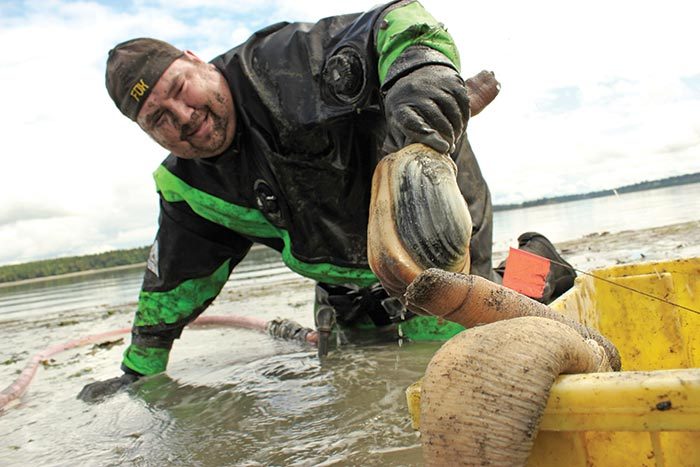First Squirrel Cove geoduck harvest ‘groundbreaking’
The headlines in the newsletter that went out to the community in early January was set in bold type:
Klahoose Shellfish Limited Partnership (KSLP) is proud to announce that there will be a harvest on our geoduck tenure just outside of Squirrel Cove.
In what was called “a groundbreaking effort”, details of the Klahoose harvest were revealed. Along with it was a history lesson in how the harvest came to be.
Divers went into waters planted with geoduck seeds in 2010 to dig up the cultured stock. “We anticipate the animals will be about 400-700 grams,” the announcement said, adding “the product will be heading over to China for the Chinese New Year at the end of January.”
In 2008, then-chief Ken Brown was president of the Klahoose shellfish company and, with support of the board of directors and Klahoose council, he successfully negotiated the purchase of a 50 per cent interest in Argosy Sea Farms and its 34-hectare sub-tidal geoduck farm. The tenure was situated just outside of Squirrel Cove, the nation’s main reserve on the east side of Cortes Island.
Two years later, Klahoose Shellfish entered into a partnership with the University of British Columbia to grow over 300,000 geoduck seeds that were planted under a canopy of nets on the ocean floor. An additional 600,000 seeds were later planted.
The current president of Klahoose Shellfish is Chief James Delorme. The board of directors consists of Kathy Francis, Doug Bourque, Dave Cyr and Johnny Hanuse.
Delorme said Klahoose was “the first Aboriginal nation to successfully create a partnership in this rewarding industry.
“This is a highly sought after, highly prized and valued product in China and we are eager to be a part of this industry.”
After the first successful planting program, Klahoose Shellfish purchased the remaining shares of Argosy Sea Farms and became sole owner of the deep-water license.
“Nine years after our initial purchase of the Argosy tenure, and seven years after planting, we are now beginning to harvest and get some returns on the original investments,” Delorme said.
The company is currently planning its assessment of geoduck planted in 2013. And Delorme said that there is an opportunity for band members to be trained aboard vessels to learn the fundamentals of geoduck science and extraction.
“In the near future, we wish to have greater involvement from our Klahoose membership in this industry,” he said. “We will be working with training groups, such as North Vancouver Island Aboriginal Training Society, to build capacity. KSLP will design a training program to further existing knowledge and introduce band members to this sector.
“This really is the start of a new day…Klahoose are leaders in economic development in forestry, green energy and now in geoduck aquaculture. We anticipate great things to come.”
Others have geoduck woes
While Klahoose harvests, other nations around the Salish Sea have been hampered in their access to the large and pricey shellfish.
Members of Stz’uminus First Nation blockaded a geoduck harvest by vessels from the Underwater Harvesters Association (UHA) in 2010. That harvest, approved by the federal fisheries department, was in Kulleet Bay within shouting distance of homes on the reserve lands.
In 2013, Chief John Elliott wrote to the federal fisheries minister: “The monopoly the UHA holds over this resource is not an effort of sustainability and conservation; rather it is a profiteering scheme that has gone on long enough.”




